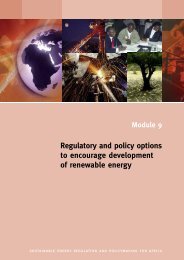Increasing access to energy services in rural areas - REEEP ...
Increasing access to energy services in rural areas - REEEP ...
Increasing access to energy services in rural areas - REEEP ...
Create successful ePaper yourself
Turn your PDF publications into a flip-book with our unique Google optimized e-Paper software.
SUSTAINABLE ENERGY REGULATION AND POLICYMAKING TRAINING MANUAL<br />
page 10.60<br />
• Maximiz<strong>in</strong>g the number of f<strong>in</strong>ancially susta<strong>in</strong>able household connections that can be<br />
achieved us<strong>in</strong>g a limited subsidy resource (focuses on the number of households);<br />
• Maximize number households <strong>to</strong> be reached, with m<strong>in</strong>imum subsidy (promote maximum<br />
private sec<strong>to</strong>r <strong>in</strong>vestment);<br />
• Maximize the socio-economic benefit <strong>to</strong> be achieved through electrification of households,<br />
<strong>in</strong>stitutions, social <strong>services</strong> and enterprises – requires rat<strong>in</strong>g of a wide range of<br />
possible benefits (this reduces the emphasis on the number of households connected);<br />
• Maximize economic benefit of electrification (will tend <strong>to</strong> place even less focus on<br />
household connections, more on enterprises/<strong>in</strong>dustry);<br />
• Least-capital cost electrification (sometimes used for grid electrification plann<strong>in</strong>g, if<br />
there is lack of <strong>in</strong>formation on consumption, and thus little basis <strong>to</strong> differentiate lifecycle<br />
revenues and costs);<br />
• Take a least cost approach <strong>to</strong> O&M <strong>to</strong> maximize susta<strong>in</strong>ability of operations (allow substantial<br />
capital subsidy <strong>to</strong> reduce O&M).<br />
Benefit po<strong>in</strong>ts system of analysis<br />
One way <strong>to</strong> support decision-mak<strong>in</strong>g on technology selection, and specifically whether grid<br />
technology is likely <strong>to</strong> be viable for certa<strong>in</strong> clusters of loads; a simple rule of thumb can<br />
be developed us<strong>in</strong>g “benefits po<strong>in</strong>ts” (BP). 1<br />
Each potential electrification project would<br />
accrue a number of “economic benefit po<strong>in</strong>ts” <strong>in</strong> order <strong>to</strong> take <strong>in</strong> <strong>to</strong> account social and<br />
economic benefits that arise from <strong>rural</strong> electrification. A system of allocat<strong>in</strong>g “benefit<br />
po<strong>in</strong>ts” can be developed <strong>in</strong> order <strong>to</strong> try and quantify these social benefits as well.<br />
For example, a “benefit po<strong>in</strong>ts” system essentially allocates one po<strong>in</strong>t <strong>to</strong> the electrification<br />
of a <strong>rural</strong> household and then compares the electrification of other <strong>in</strong>stitutions and<br />
<strong>in</strong>dustries aga<strong>in</strong>st this reference. As an example, electrification of a small shop or another<br />
trader is considered <strong>to</strong> provide three times more economic benefit as a household on the<br />
basis of the potential for <strong>in</strong>creased <strong>in</strong>come generation that may accrue through electrification.<br />
So a small shop is allocated three benefit po<strong>in</strong>ts. The electrification of a health centre<br />
might accrue 70 benefit po<strong>in</strong>ts.<br />
The benefits po<strong>in</strong>t allocation system aims <strong>to</strong> take <strong>in</strong><strong>to</strong> account both the size of the load<br />
(<strong>in</strong> kWh for <strong>energy</strong> consumption or kW for power demand), its contribution <strong>to</strong> the overall<br />
f<strong>in</strong>ancial feasibility of the l<strong>in</strong>e extension, as well as its weight<strong>in</strong>g for social benefits. The<br />
benefit po<strong>in</strong>ts for proposed projects are then summed <strong>to</strong> assess the <strong>to</strong>tal potential benefit<br />
of a particular project.<br />
The benefits of po<strong>in</strong>t analysis will prove useful <strong>in</strong> the <strong>rural</strong> electrification process and will<br />
be mentioned wherever appropriate <strong>in</strong> the follow<strong>in</strong>g section.<br />
1<br />
This system was first proposed for use <strong>in</strong> Namibia and South Africa and has been adapted for use <strong>in</strong><br />
Uganda.










